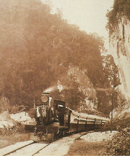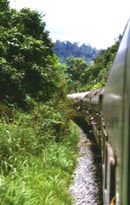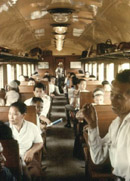Take The Train One Way and Fly Back The NextPrepared by Harold Stephens
Travel Correspondent for Thai Airways International
Any one of Asia’s many train trips can be exciting but the problem is the return trip. It can be boring if you have to repeat the same route. There is a solution. Take the train one way and then take a Thai Airways flight back.
As for what train to take, there’s no shortage in Asia, everything from coal burning chuggers to sophisticated modern expresses. Each one is an experience in its own right. And as I recommended, since most trips are one-way journeys, the traveller can travel one way by train and return by Thai Airways.
Travellers usually have fixed ideas about train travel in the East. Generally, what comes to mind when you mention train journeys in Asia—the Orient Express!
Few names can conjure up more romance than the mention of the Orient Express. Intriguing plots for spy stories, novels and movies, all have been built around this legendary train trip from Europe to Asia.
There is only one problem: the name is a misnomer. It’s true, there was once a transcontinental Orient Express, and it did start in Europe, but it terminated where Asia merely began, at the gates of Istanbul. Although a Europe-Asia line may have been a great dream of rail magnates from time to time, there never has been a through train from Europe to the Far East, say from London to Singapore. The gaps in the route are too many—eastern Iran, Afghanistan, Burma, nor does such a dream look hopeful in the near future. In fact, 50 years ago it was easier to travel a greater part of the distance by rail than it is today.
But rail buffs travelling in Asia need not fret; there are some great train trips that would be hard to equal in the West. You hear talk and see advertisements about the E&O Orient Express, but this line, which is quite new, doesn’t connect Asia to Europe. It runs from Bangkok down the Malay Peninsula to Singapore; but more about it later.
Every Asian country, with the exceptions of Afghanistan and Laos, has at least one railway in operation, some offering exceptional rides. In the island Republic of Indonesia, for example, there’s a very popular line, and air-conditioned, which operates a daily service between Jakarta and Surabaya. The only negative thing about the trip is that it’s overnight, and there’s not much you can see in the dark.
If you happen to be in Savannakhet in Laos, and go to the railway station there, don’t expect to buy a ticket. There’s no railway, only a station. The French, it seems, built the station but never got around to constructing the rail line.
Nevertheless, there are some exciting rail journeys. Most train travel in Asia, however, is within individual countries, with one exception, an international service from Bangkok down through Malaysia to Singapore. It’s a two and a half day journey that runs the entire length of the Malay Peninsula.
The E&O Orient Express has been in service only a few years. It’s the talk of Asia today, with its first-class, quality service. The special service is an attempt to recapture the old Orient Express aura of yesteryears. So far, however, there have been no murders to live up to its namesake. Nevertheless, it’s “coat-and-tie dining” on gourmet meals and provides luxury private compartments, with hot showers and room service.
On the other hand, the old International Express, that has been around for decades, is another one from Bangkok to Singapore. A second-class, air-conditioned sleeper, from Bangkok to Singapore, is a mere fraction of the cost of the E&O, but, as one might think with such a price discrepancy, the International Express must really be a cattle-car train. It isn’t. In fact, it’s a very pleasant and comfortable train trip.
My complaint is that I enjoyed travelling much more in non-air-conditioned cars. The price has nothing to do with it! It was pleasant to travel with windows open. I liked to look out of an open window; I liked to feel, to smell, to breath in the countryside; to let the wind blow in my face; and when we reached a station and the train came to a halt, I liked to listen to sounds—the milling, the shouts of the people, the conductor’s whistle, the chants of the vendors, and from these vendors, carrying heavy-laden trays and baskets upon their heads, I liked to buy all those delights the Thais have to offer—barbecued chicken with red sauce, sticky rice in bamboo with mango, baked fresh corn in its husk, sweets neatly wrapped in woven green leaves, tropical fruit and so much more.
Today, all the cars are air-conditioned, with the exception of third class. You can still find a few vendors on the platforms selling their wares, but now you have to step off the train to buy from them. It’s not quite the same.
Not long ago, I made that trip on the International Express. The train departs exactly at four o’clock in the afternoon and makes a grand sweep through Bangkok before turning south towards the Gulf of Thailand. The train rumbles across a bridge over the mighty Chao Phraya River and the city gives way to industrial sites and finally open farm lands, mostly rice fields.
They call it the International Express but the stops are frequent, every half hour or so. My second disappointment, other than non-opening windows, is that there are no longer dining cars. Hostesses take orders for dinner and breakfast and deliver the meals to your seat. Both Western and Thai food is offered on the menus. No more sitting up half the night in a dining car drinking Singha beer or ‘Mekong and soda’ with train guards and policemen. I don’t even know if they have the guards any more. Train robberies aboard the express were once common, but robbers these days find the tourist business more profitable.
Relaxation is the key to train travel. It’s your chance to read, gaze out the window, or just nap. The tune of “clickity-clack” as the train rumbles down the track is bewitching. But, if you are like me, you can’t nap very long. There’s too much to see. I can’t take my attention away from looking out the window, watching the countryside flash by. It’s a lazy mood, a much needed mood in our modern day of constant rushing.
The conductor began to make up the sleeping berths around eight o’clock. I sat up and watched a magnificent flaming red sunset. We were in an area where limestone outcroppings raise up high from a flat plain and they look more like skyscrapers than the works of nature that they are. The setting sun plays hide-and-seek behind the mounds and then disappears. I waited but it didn’t reappear; only the reddened sky remained. It was time to turn in.
I had a lower berth; I climbed in, pulled the curtains closed, undressed and again waconscious of the sound, clickity-clack, clickity-clack. The motion of the train was surprisingly smooth, like that reporter had said a hundred years ago, and sleeping is enjoyable.
It was a beautiful morning, and I felt rested after a great night’s sleep. I had breakfast at my seat. Rice fields in every shade of green appeared. No more water buffalo. Farmers now tend their fields with two-wheel tractors that look like push carts.
Trains are nonsmoking, which really must be hard on the Chinese. I remember cars filled with smoke, and the Chinese coughing at night, and especially in the morning. Chinese are noisy. They have to scream and shout, and they let their kids run wild. Two Cantonese gentlemen sat in the next compartment, across from each other, and they spoke so loudly it sounded like they were fighting, but it was only a friendly conversation in their harsh southern Chinese dialect. Mandarin Chinese, the dialect of the north, is not like this. In fact, it’s rather pleasant sounding. But few Chinese in Southeast Asia speak Mandarin.
I wandered around the train and walked through the third class compartment. It was non-air-conditioned and the windows were open. There were a few foreigners, backpackers, blocking the isles with their huge overweight packs. They slept curled up on their reclining seats. The overhead ceiling fans buzzed wildly.
It was ten in the morning when we arrived at the Thai-Malaysian border, where we had to go through Customs and Immigration. Passengers must take their luggage and belongings with them and proceed to customs. The Malay immigration officers couldn’t be nicer, even when they told me it is forbidden to take photos, after I had already snapped half a dozen shots.
At noon we’ll arrived at Butterworth, the terminal across a narrow strait from Georgetown, the capital of Penang. After a pleasant night on the island, I left the next morning at eight by train for Singapore. I arrived that night at ten.
As I mentioned, for the return trip visitors can take a Thai Airways flight from both Penang and Singapore. QUESTIONS & ANSWERSQ. Hi there, I’m approaching my retirement years and have for many years wondered what it must be like to sail around the South Asian seas on one of those exotic Chinese or Siamese junks. I’m guessing that Thailand would have trips like that. Do you know any websites or companies I could enquire to? I’d love to take my wife somewhere special when my working days draw to an end. Many thanks, Ren Weiscoff. Detroit, Michigan.
A. Dear Ren, You are in luck. A company called Thai Marine Leisure operates a fleet of authentic junks in Phuket. The other good news is that you can book a junk cruise through Royal Orchid Holidays. There’s a four days, three nights that departs Saturday (ROHA4A) and Tuesdays (ROHA4B). Marine Leisure also has a one-day trip aboard the Bahtra. I haven’t made the junk trip but I am looking forward to it one day. I wrote in detail about junk trips in my book TAKE CHINA that you may enjoy. I did take a photo of Suwan Macha, the junk for the four-day voyage, when I was in Phuket last. It looks like a fun trip and I know you will enjoy it. Happy retirement. —HS
Harold Stephens
Bangkok
E-mail: ROH Weekly Travel (booking@inet.co.th)
Note: The article is the personal view of the writer and does not necessarily reflect the view of Thai Airways International Public Company Limited. | 
Coal-burning trains gave way to diesel engines | | 
The Bullet Train in Japan offers a thrilling ride | | 
For a unusual ride, the Toy Train in the Himalayas | | 
Old trains make good museum pieces | | 
Kids love old trains
| | 
The Express from Bangkok to Singapore
| | 
Third class trains not comfortable but interesting
| | 
Train station in Bangkok
| | 
Station in Hua Hin
| | 
Train at the Queen’s Craft Centre near Ayutthaya
| | 
For more about sailing junks read Take China
|
|





